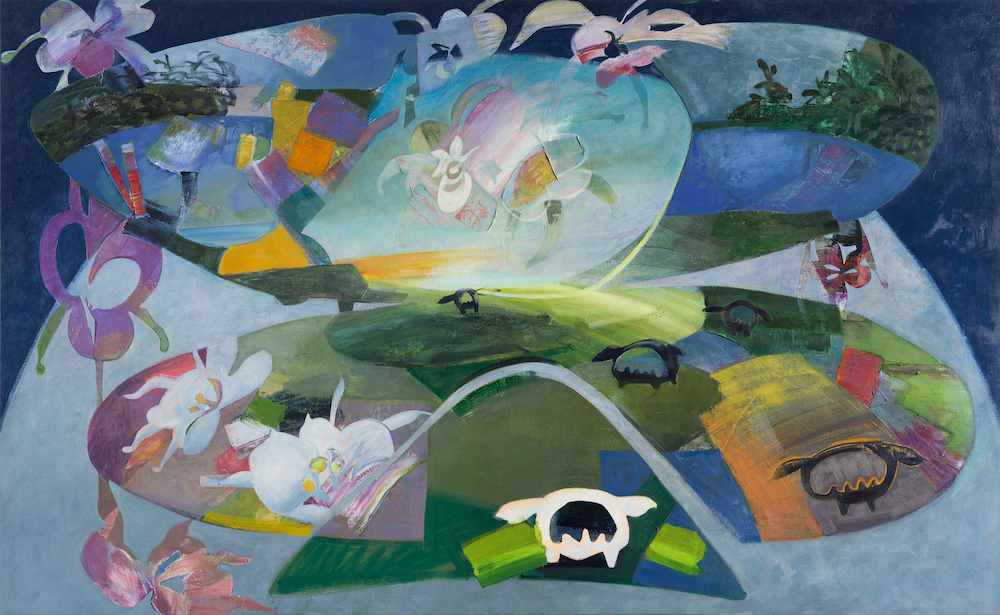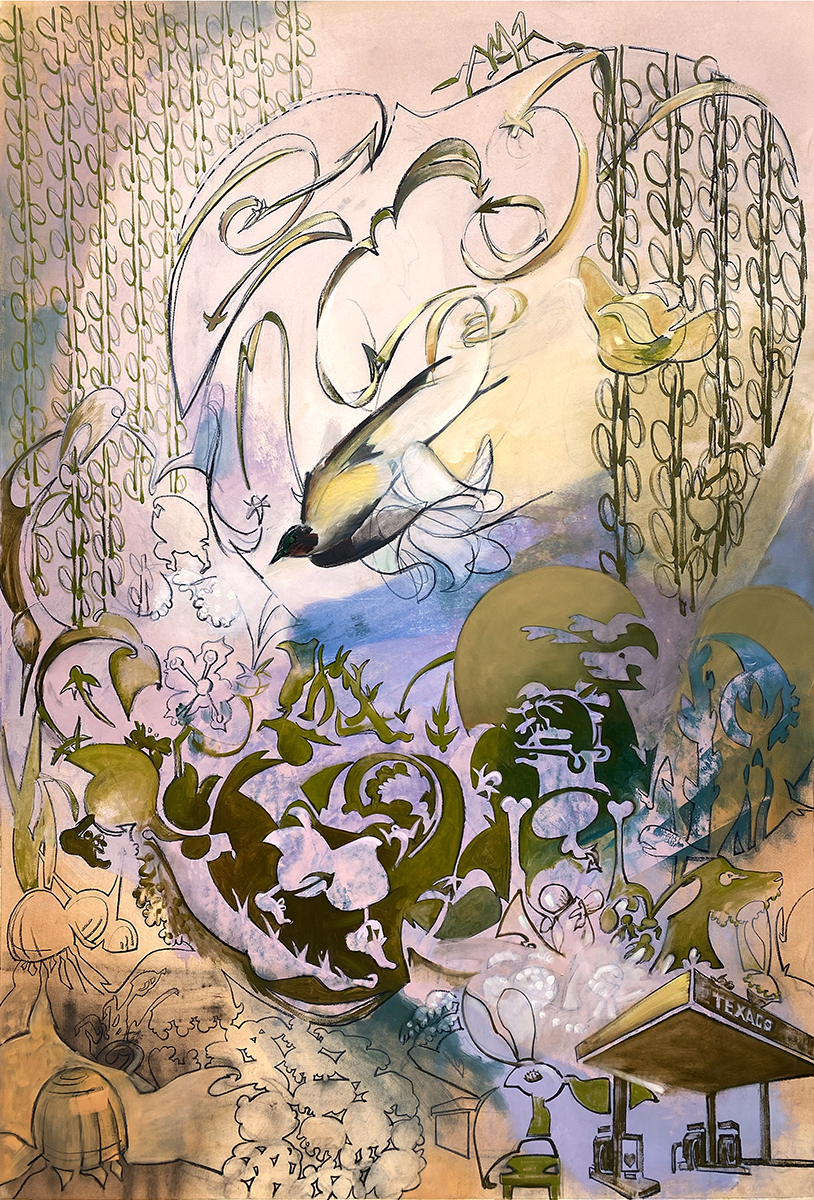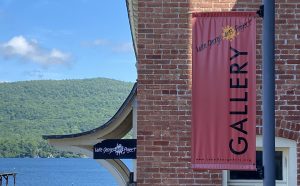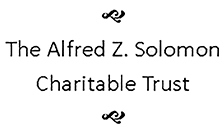
- This event has passed.
Mike Glier: The Forests of Antarctica
May 8, 2024 @ 12:00 pm - June 8, 2024 @ 5:00 pm

Artist’s Reception
Saturday, May 11, 2024
4:00 – 6:00 PM
Zoom Conversation
Wednesday, May15, 2024
7:00 PM
Recorded Zoom Link
Sunday Arts
Sunday, May 26, 2024
1:00 – 4:00 PM
Gallery Tour and Art Workshop for all ages

Images: (Top) Crying Beasts, 2017, oil on linen,
48” x 78″
(Above)There Is a Faint Odor of Petroleum and the Birds Are Singing, v.2, 2021, oil and charcoal on Arches Watercolor paper, 72.5 ” x 49.5″
Artist’s Statement
The Forests of Antarctica paintings began by accident while working in the South Island of New Zealand, which is a windy place, effected by weather coming north from the Antarctic. When painting out of doors in the wind, the panel often became a sail and lifted from the easel with the breeze. On days like this, I took up pencil and paper and attempted to draw the wind. Encouraged by the unexpected results of drawing something that is invisible, but can be felt, I began to include sound and smell and touch as sources.
I’m not by nature a synesthete, but this attempt to train myself to be so has created drawings and paintings that are more associative than descriptive of particular landscapes. The title, The Forests of Antarctica, places these imagined places in the very distant past when Antarctica was warm or the uncertain future when Antarctica may be warm once more.
The process for this new work begins out of doors, with plein air drawing and color notation. Back in the studio, the studies are combined into large, black and white, oil on paper compositions that emphasize positive and negative reversals. Each form in these pictures is self-contained, but since it shares edges with other forms, the integrity is dependent on its neighbors. Like an ecosystem the forms are at once discrete and dependent, and like things glimpsed while hiking, they flicker into consciousness and dissolve into space. Once the black and white study is complete, the color studies are consulted and the painting begins. The paintings are large, about 6’ x 10’, which is enough to envelope the viewer in a somatic experience.
I worked in four locations, the Berkshires, the coast of northern Maine, the central mountains of New Mexico, and the island of St. John, which is a Biosphere Reserve. It was in St. John that I began to understand the relevance of the plein air process in the 21st C. When drawing and painting out of doors, there isn’t a break between thinking and doing. In the best moments there is no lag between the movement of the sun and the wind and the response of the brush and the knife. Stimulus and response becomes a single thing and the experience is one of feeling very connected with the subject. It’s a delightful state of being in which what is inside gets thoroughly mixed up with what is outside. These paintings are a record of those kinds of moments and a demonstration of the human potential for empathy.
No matter what the fate of our species may be, the natural world of the future will be exuberant. I hope these landscape pictures advocate for responsive and respectful engagement between people and the environment. I hope they advocate for intimacy with what’s outside. If there’s any sort of environmental agenda here, if there’s anything useful to what I’m doing culturally, it’s about modeling a relationship with what’s outside that is reciprocal. This performance is not about domination nor is it about submission; it’s about engaging in a partnership responsibly and happily.

The Forests of Antarctica 589, 2018, oil on primed paper, 43″ x 58″
Bio
Born in Kentucky, Mike Glier studied psychology and art at Williams College, Williamstown, Massachusetts before attending the Whitney Museum Independent Study Program. An advisee of Robert Morris, Glier received an MA from Hunter College in 1975. His master’s thesis, “The 1979 Dime Store Figurine” appeared in Artforum Magazine the following year.
Living in New York City in the 1980’s, Glier was an active member of Collaborative Projects, participating in the Time Square Show and organizing Art Direct, a mail order catalog of art works. He, also, participated in several Group Material exhibitions including “Mass”, “Resistance”, “The Constitution”, “Politics”, and “AIDS Timeline”. In relation to the feminist dialog at the time, Glier made a series of drawings and paintings about the white male identity, which were exhibited at Anina Nosei Gallery under the title, “White Male Power: Senators, Game Hosts, National Monuments, Popes, etc.” During his years in New York, he was engaged with the artists’ book distributor, Printed Matter Inc., serving on the staff and then the Board of Directors.
In the late 80’s Glier moved to upstate New York to begin a family and at Williams College a teaching career, which he considers a happy, satisfying, and dematerialized part of his creative output. Glier is currently the Alexander Falck, Class of 1899 Professor of Art. To celebrate the birth of his daughter, Glier created a 26 panel painting installation entitled the “Alphabet of Lili”, which not only documents the hopes and fears of raising a child but, also, the changing roles of men. Now living in the country, Glier was inspired by its visual beauty, but also by the urgent reality of a deteriorating natural environment and as a result he begin making art about landscape. In 2007 Glier completed Along a Long Line, a series of plein air paintings created along a line of longitude that stretches from the Canadian Arctic, through New York City and ends on the equator in Ecuador. He has recorded this effort in a book, “Along a Long Line”, published in 2009 by Hard Press Editions. The human relationship to the natural world continues to be the main focus of his work. Derived from drawings made in the forests of Berkshires, the coast of Maine, the central mountains of New Mexico and the Virgin Islands, his current painting series, “The Forests of Antarctica”, envisions an exuberant future in a changed climate.
Solo exhibitions of Glier’s works have been presented at a variety of venues including The Kitchen, New York; Rhona Hoffman Gallery, Chicago; Barbara Gladstone Gallery, New York; Galerie Tanja Grunert, Cologne; Barbara Krakow Gallery, Boston; San Jose Museum of Art, and the Museum of Modern Art. He has completed several permanent installations, including the memorial to Carl Friedrich Goerdeler for the City of Leipzig, Germany (in collaboration with Jenny Holzer), and “Town Green” a wall drawing installation for the Cambridge, Massachusetts, City Hall Annex. “Town Green” was selected by Americans for the Arts as one of the best public art works of the year. A ten-year survey of his work was mounted at Hallwalls, Buffalo NY in 1988 and a 35-year survey was mounted in 2014 at the Opalka Gallery, The Sage Colleges, Albany. A book entitled “Meander, Because You Can’t See Much While Marching”, which includes essays by Thomas Crow, Lucy Lippard, and David Breslin accompanies this survey. The Drawing Center, NY and The Tyler Gallery, Temple University, have also sponsored national touring shows of his painting.
Glier is the recipient of a National Endowment for the Arts grant in drawing and a Guggenheim Fellowship in painting. He has had residencies at the Liguria Study Center, Bogliasco Italy; Dorland Mountain, Temecula, CA: Blue Mountain Center, Blue Mountain, NY: Herekeke, Lama, NM;, Hauser and Wirth Gallery, Somerset, UK; Burchfield Penney Art Center, Buffalo, NY.

Courthouse Gallery 1 Lower Amherst Street Lake George, NY 12845 518-668-2616
Hours: Wednesday – Friday: 12:00 – 5:00 Saturday: 12:00 – 4:00 Sunday, March 24, 2024: 1:00 – 4:00
For exhibition information or to schedule a visit outside of gallery hours please contact
June Waters, Director of Exhibitions
june@lakegeorgearts.org
518-668-2616
THANK YOU! This exhibition is funded in part by the Town of Lake George, the Village of Lake George, The New York State Council on the Arts, the Glenn & Carol Pearsall Foundation, the Alfred Z. Solomon Charitable Trust, Anonymous, and Lake George Arts Project Members. Please Join us today!
We would also like to thank our Media Sponsor: 518 Profiles




